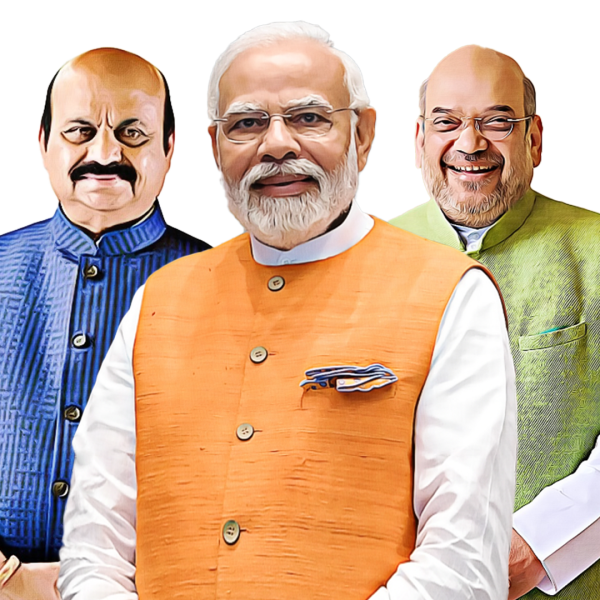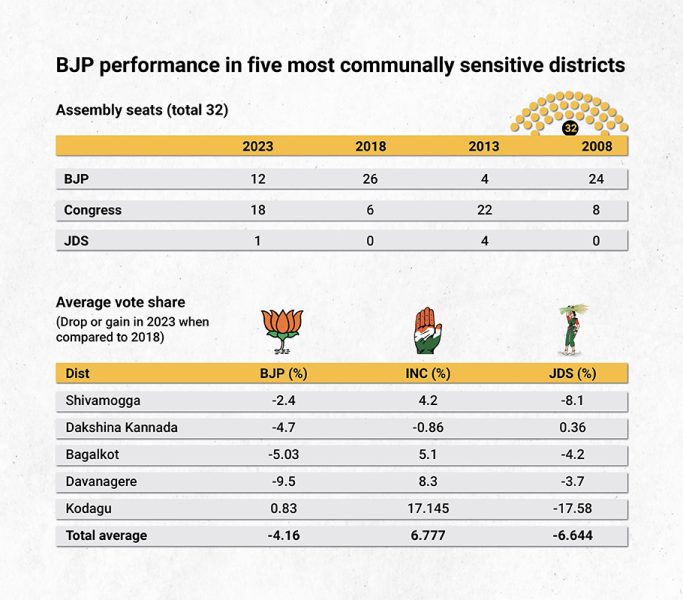
How BJP’s Hindutva experiment bombed at electoral box office in Karnataka

Analysts are divided over how Hindutva, BJP’s flagship programme, fared at the last month’s elections in Karnataka. As BJP slumped from 104 to 66 seats, many think the verdict was a setback to the party’s pet agenda, which consumed the bulk of its political capital.
But the BJP managed to hang on to its vote share, which dipped only marginally by 0.2% to 36%. The party’s absolute number of votes increased by eight lakhs and its vote share also spiked in several constituencies where it had a token presence earlier. This for many is a sign that Hindutva is potent and kicking.
Both the groups agree that after forming the government in 2019, the BJP went out of its way to push its core agenda. It even took the risk of purging BS Yediyurappa, its most popular leader, who was seen as an obstacle in pursuing its priorities.
A source close to Sangh parivar had said, “Theb RSS realised that the BSY’s government was as useless as Atal Bihari Vajpayee’s NDA 1 when it came to pursuing its programme. So, he had to go whatever the cost.”
Pliant Bommai gives free hand
Under a more pliant Chief Minister Basavaraj Bommai, the Sangh parivar ran a shrill multi-pronged campaign targeting minorities, mobilising footsoldiers, rewriting text books and plays and unleashing its top leaders to inject a daily dose of hate speech.
It launched back-to-back campaigns on sensitive issues such as azaan, hijab, halal, boycott of Muslim traders and Tipu Sultan, which dominated the headlines throughout Bommai’s controversial two year reign.
Also read: BJP lands in quota quagmire ahead of Karnataka assembly elections
There was a spike in communal violence in at least 10 districts, which witnessed murder, stabbings, pitch battles, massive processions, damaging of public property and shutting down of towns.
Though the BJP sought to go easy on the polarisation as elections approached, the Congress manifesto, which promised to ban Bajrang Dal and the BJP’s furious response to it, led by no less than the Prime Minister himself, brought the issue back into focus.
Hindutva: Diminishing returns?
To be sure, several reasons contributed to the BJP’s defeat ranging from anti-incumbency to a skewed distribution of tickets. But given the party’s preoccupation with Hindutva, it’s tempting to ask if its raison d’etre led to the electoral debacle or helped it to mitigate the loss.
If the Sangh parivar’s strategy was to polarise the votes, it failed as Muslims, Dalits and many other social groups came together with the singular objective of countering it.
Veteran Hindutva watcher Aakar Patel, says “I assume that the majority of Kannadigas were put off by the Hindutva campaign. It found less resonance in Karnataka and it failed to polarise.”
The stunning defeat of the BJP also calls into question the long-term efficacy of Hindutva in mobilising votes for the party. The BJP won 33.9% of the popular vote in 2008, the year the Lotus formally bloomed in the state.
After 15 years of mobilisation during which it was in power for nine years, its vote share has grown by a mere 2.1%. Between 2008 and 2023 elections, its seats have dropped from 110 to 66.

Psephologist Sandip Shastri says the BJP reached a saturation point in Hindutva mobilisation in 2018 when it won 36.2% vote share and 104 seats. “It has reached the limit in the state,” he adds.
Though Hindutva looks like a formidable electoral strategy in many North Indian states, its limitations in fetching votes are surfacing in Karnataka. The performance of the BJP in select districts, which bore the brunt of its communal mobilisation, brings home the challenges it faces in polarising the society.
The Hindutva laboratories
After the bBJP came to power in 2019, communal temperature soared across the state with Shivamogga, Dakshina Kannada, Bagalkot, Davanagere and Kodagu districts emerging as top hotspots.
Also read: RSS mouthpiece on Karnataka lesson: Modi charisma, Hindutva not enough
Though these regions have had a long history of communal conflict, the Hindutva mobilisation and its fallout escalated under Bommai, and according to official data, incidents of communal violence shot up from 16 in 2020 to 96 in 2022.
The heightened Hindutva campaign failed to translate into votes in the 2023 election. In the 32 constituencies of these five districts, the BJP tally dropped from 26 seats in 2018 to 12 and its average vote share shrunk by -4.1%. The Congress improved its tally from 6 to 18 and its vote share by 6.7%.
While it’s clear that just the manufacturing of communal tension does not translate into votes, the strength of Sangh parivar and the challenges it faces are not uniform across these districts. In a few constituencies it seems to have achieved its polarisation objective, but in most it is work under progress, with the outcome far from given.
The consolidation in Shivamogga
Outside the two coastal districts, Dakshina Kannada and Udupi, Hindutva forces seem to have consolidated the most in Shivamogga. The district’s several influential left-leaning institutions have yielded space to the Sangh parivar foot soldiers, who can now shut down any event not to their taste.
The district topped the dubious list of top 5 communal hotspots with 42 communal violence incidents in 2022. The Shivamogga city saw the worst communal flareup of the year when a Hindutva activist was killed. Hindu and Muslims groups also clashed over Savarkar and Tipu Sultan posters and the police had to open fire to get the situation under control.
Despite the palpable polarisation, the BJP’s tally in the seven constituencies of the district dropped from six seats in 2018 to three. Congress, which had a lone MLA, won three seats. The vote share of the Congress went up by 4.2% while BJP’s declined by -2.4%.
Shivamogga city looks like a Hindutva fortress where the BJP can get any candidate elected on the strength of its ideology and committed cadre. But it is yet to gain that strength in the other constituencies. Despite a major clash, it lost the Sagara seat, where its vote share also dipped by 6.8%. In Shivamogga city its vote share dipped by -6.7% probably due to a change of candidate.
With the Congress coming to power, the going gets harder for the Sangh foot soldiers, who usually thrive under a BJP government.
Dakshina Kannada
The original Hindutva laboratory of the state, Dakshina Kannada saw seven clashes in 2022. In its eight constituencies, BJP’s tally dropped from seven seats in 2018 to six and its vote share came down by -4.7%%. Congress tally improved from one to two seats, but it also lost its vote share by 0.86%.
The BJP’s loss did not benefit the Congress as it takes a strong opposition to benefit from the Hindutva woes. The Congress seems to be too emaciated in the district to provide an alternative.
While the Sangh parivar appears unshakable in Dakshina Kannada, it failed a crucial test. Hindutva is not just an ideological sweep, it also assumes a command and control relationship between the mothership and stormtroopers, and an ability to get any candidate elected under its banner.
Also read: Karnataka polls | CM Bommai: BJP couldn’t make the mark despite PM, workers’ efforts
The BJP has found it hard to control its foot soldiers on many occasions. In Puttur, it ignored the claim of a strong contender from Hindutva ranks, who stood as a rebel, splitting party votes and handing over an unlikely win to the Congress.
SDPI, which represents the Muslim counter to Sangh parivar, won 2.1% vote from the five constituencies it contested. The more it grows, the more it gets easier for the Sangh to consolidate its votes.
Bagalkot
Bagalkot district, which reported 16 communal clashes in 2022, shows what happens when Hindutva faces a strong opposition in a bad year. In the seven constituencies here, the vote share of the BJP slumped by -5% and of the Congress, it went up by 5%. What the BJP lost, the Congress gained in an equal measure.
In terms of seats, BJP came down from five in 2018 to two, and the Congress went up from two to five, a neat reversal of fortunes.
Kerur in Badami constituency witnessed a communal clash in which three were stabbed and 18 arrested. Congress retained this seat though with a loss of -2.2% vote share. The BJP’s anticipated polarisation benefit did not materialise and the party lost its vote share by a steeper -7%. Both the parties lost votes to a JDS candidate whose vote share jumped by 9.6%. This was an exception in an election, which saw JD(S) mostly losing votes to the other two parties
Bagalkot, like Davanegere which follows in the second part of this series, shows that Hindutva is incapable of mobilising votes on its own in Karnataka. It falls by the wayside when voter mood sours for any reason and faces strong local opposition. An absolute ideological hold over the people and a formidable organisational strength, which can defend lack of governance, are limited to a few pockets. As things stand there are more Bagalkots than Shivamogga city in the state.
(Read Part 2 of this article on June 17, 2023.)


